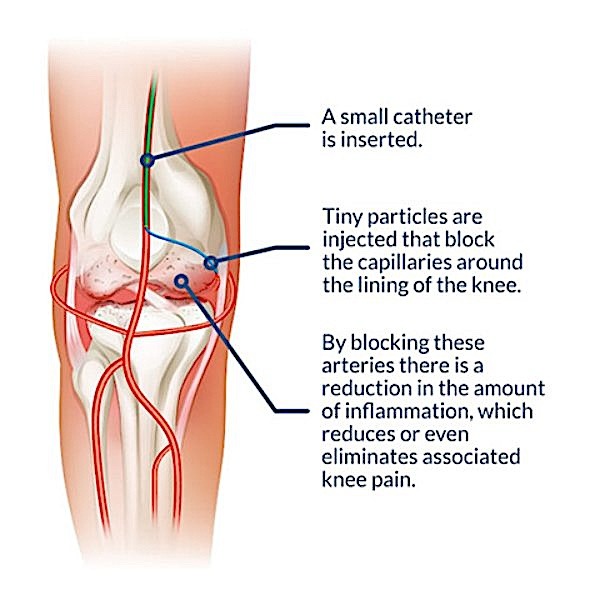GENICULAR ARTERY EMBOLISATION MELBOURNE
KNEE PAIN TREATMENT FOR OSTEOARTHRITIS
Learn about Genicular Artery Embolisation including the procedure, benefits, risks and more:
GENICULAR ARTERY EMBOLISATION MELBOURNE
Source: Dr Philip Chan – MBBS, MMed (Radiology), FRANZCR, EBIR.
Interventional Radiologist.
WHAT IS A GENICULAR ARTERY EMBOLISATION
What is Genicular Artery Embolisation (GAE) – Genicular Artery Embolisation is a new, minimally invasive procedure used to treat chronic knee pain, caused by osteoarthritis.
It involves injecting tiny particles into the genicular arteries, which supply blood to the knee joint, to reduce inflammation and pain by limiting excess blood flow. The procedure is performed under local anesthesia using fluoroscopic (X-ray) guidance.
GAE is ideal for patients who are symptomatic but don’t meet criteria for joint surgery or want to try a less invasive treatment before joint replacement. This procedure may also be helpful for patients with persistent knee pain and bleeding into the knee joint after a joint replacement.
Recovery is quick, with most patients experiencing pain relief within weeks. It is a safe and effective option for managing knee osteoarthritis symptoms.

Source: UCLA Health – Genicular Artery Embolisation
HOW IS A GENICULAR ARTERY EMBOLISATION PERFORMED
Genicular Artery Embolisation – A Genicular Artery Embolisation is a minimally invasive operation which is performed through a 2-3 mm hole through the artery in the groin.
Using real-time imaging, a microcatheter, a small hollow plastic tube, is carefully navigated into the genicular arteries which supply blood to the knee joint.
Once in position, microscopic particles are injected into the local arteries, until there is reduced blood supply to the lining of the knee joint. By blocking these arteries, there is a reduction in the amount of inflammation associated with osteoarthritis helping to reduce the associated knee pain.
The operation typically takes 45 minutes to an hour, and can be safely performed under sedation and local anaesthesia.
Most patients experience pain relief within weeks of the procedure.

Source: UCLA Health – Genicular Artery Embolisation
WHO IS A SUITABLE CANDIDATE FOR A GENICULAR ARTERY EMBOLISATION
A Genicular Artery Embolisation may be suitable for you if you have:
Knee pain caused by osteoarthritis
Failed other non-operative management such as steroid injections, pain killers and physiotherapy
Suffered side effects from pain killers
Mild to moderate osteoarthritis – Medical literature suggests a Genicular Artery Embolisation may be less effective for end stage or severe osteoarthritis
Wish to avoid a major knee operation.
A Genicular Artery Embolisation only requires local anesthesia and sedation, has minimal risks, and has a quick recovery time compared to traditional open surgery.
ADVANTAGES OF GENICULAR ARTERY EMBOLISATION
A Genicular Artery Embolisation procedure has the following advantages:
High technical success rates (99.7%)
Minimally invasive – Uses small incisions (2mm – 3mm) and specialised surgical tools to reduce tissue damage and pain compared to traditional surgery.
Short hospitalisation & recovery
Significant knee pain reduction after 1 month, 90% sustained effect after 1 year, 70% after 2 years
Low major complication rates (<1%)
Most side effects are mild and temporary
Allows early return to rehabilitation programs – Physiotherapy and better overall mobility when compared to traditional surgery.
PREPARING FOR A GENICULAR ARTERY EMBOLISATION
Preparing for a Genicular Artery Embolisation – Your doctor and the WIRES Radiology team will discuss with you the procedure process and hospital administration needs.
Investigations and tests – You may require more relevant investigations such as blood tests, ultrasound, CT or MRI as part of your preparation for the procedure.
Fasting and overnight hospital stay – Generally, you are required to fast for 6 hours before the procedure. Please prepare for an overnight hospital stay (even if you are expecting to be discharged the same day).
Driving – Have someone to drive you home after the procedure.
Medications – Your doctor will review your list of medications and advise which medications you may need to stop before the procedure and when you may resume taking them again.
RECOVERY – AFTER A GENICULAR ARTERY EMBOLISATION
Going home – Most patients can expect to go home the same day.
Pain management – Your knee pain will likely worsen before it improves and is usually worse in the first 12-24 hours after the procedure. You may also notice some skin mottling over the treatment area, which should improve over the next 1 to 2 months.
Post embolisation syndrome – Post embolisation syndrome is caused by the body’s reaction to the operation. Patients often feel fatigued, have low grade fever, nausea, vomiting, low appetite, generalised muscle and joint aches – similar to having a cold without the head symptoms.
These symptoms are easily managed with paracetamol and ibuprofen, and should resolve after 7-14 days.
Your doctor will discuss with you and answer any questions you may have in relation to your rehabilitation, activity, medication and recovery.
FREQUENTLY ASKED QUESTIONS
A Genicular Artery Embolisation is generally a short 45 minutes to 1 hour procedure. Most patients can expect to return home the same day.
Light activities – Light activities can typically be resumed within two weeks following the procedure.
High-impact activities – We recommend avoiding high-impact activities for at least four weeks after the procedure.
Please discuss your rehabilitation with your doctor.
First month – After your initial recovery period of 1 month, most patients will have a significant reduction in knee pain.
Ongoing relief – Although Genicular Artery Embolisation does not provide a permanent cure for knee osteoarthritis, it may provide significant knee pain relief for a minimum of 1-3 years.
Risks – Like any medical procedure a Genicular Artery Embolisation carries certain risks. Potential risks include:
- Bruising in the groin (insertion site)
- Temporary skin rash over the knee
- Temporary numbness at the insertion site (rare).
However, these risks will be closely monitored and managed by the medical team throughout the procedure and are uncommon.
When compared to traditional knee replacement surgery, a Genicular Artery Embolisation has a reduced risk of:
- Bleeding
- Infections
- Fewer potential complications
Your doctor will outline all the risks specific to your situation.
Genicular Artery Embolisation is usually well-tolerated as it is a minimally invasive interventional radiology procedure performed under local anaesthetic.
Immediately after the procedure – After the procedure, some patients experience mild to moderate soreness, swelling, or aching in the knee.
Most patients feel only mild discomfort or pressure as the catheter is inserted and guided to the knee’s blood vessels. A local anesthetic is used at the insertion site, which helps minimise pain.
Post surgery – Pain relief from the procedure’s effects on knee inflammation often begins within a week or two. Any post-procedure pain is generally manageable with over-the-counter medications.
Common side effects include mild pain, fever, and temporary discomfort. Serious complications are rare but can include issues with the arteries or surrounding organs.
Your doctor will fully explain the procedure and any potential side effects and mitigation strategies to make you as comfortable as possible during and after the procedure.


